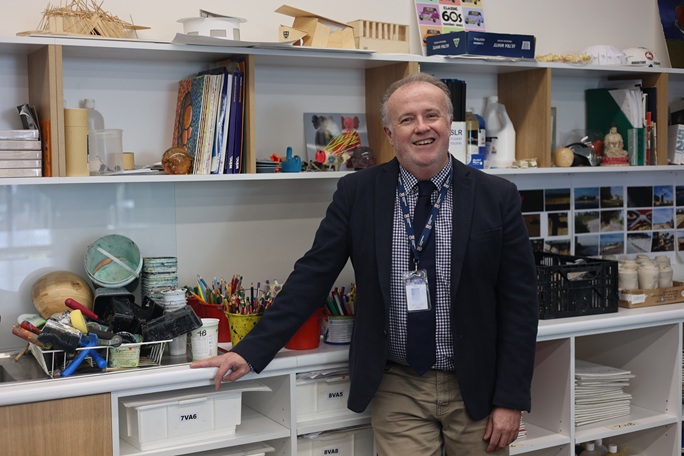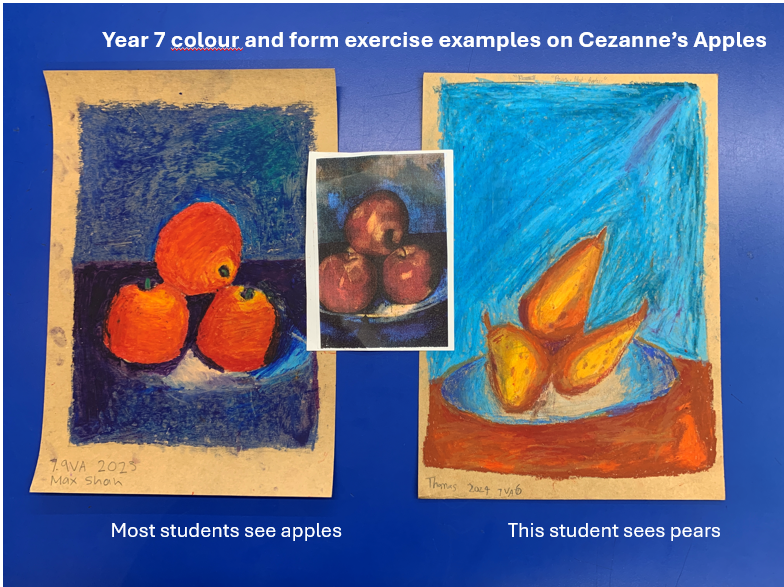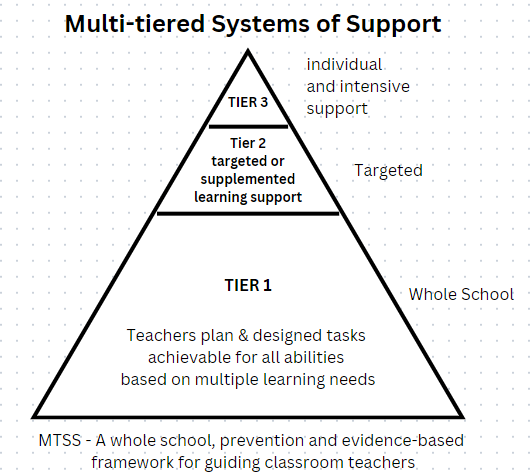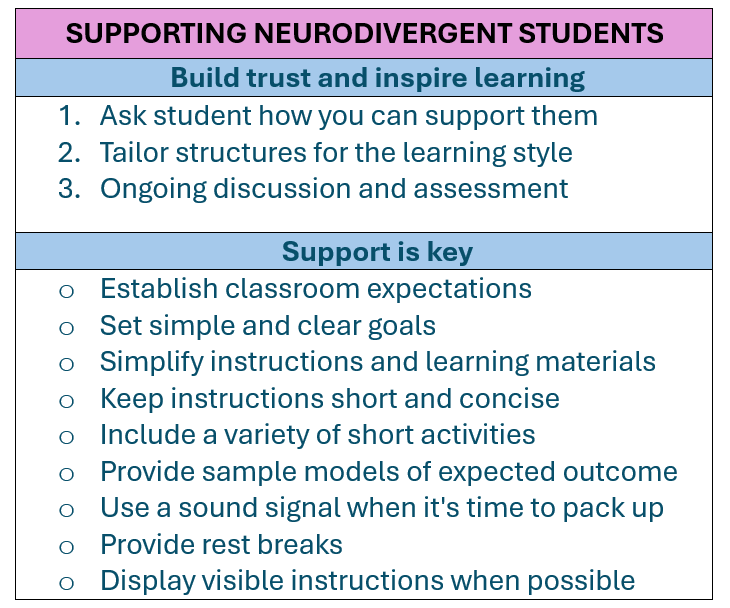
Nestled on a beautiful campus overlooking Sydney Harbour, Cranbrook School fosters a tightly-knit and supportive environment where diverse learners thrive in and outside the classroom.
Each day, staff and students come together to celebrate individuality and embrace unique learning challenges. The school supports students with conditions like ADHD, anxiety, mild intellectual disability, and autism by tailoring teaching strategies to meet their needs.
To ensure every student is not only captivated but also achieves meaningful learning outcomes, the school’s teachers observe, engage, and adapt their approaches.
One of them is Cranbrook Senior School Art Teacher, Julian Wrigley, who shares the lightbulb moment that encouraged him to complete a Graduate Certificate in Education (Inclusion Education) at Queensland University of Technology. This qualification equipped Wrigley with enhanced learning approaches and techniques that inspire students with neurodivergent minds to learn and thrive.
“There was a student in my class distracting me with disruptive behaviour which took my focus away from other students,” Wrigley told The Educator. “I considered why I was getting worked up and discovered that it wasn’t the student who needed to change, it was me who needed to change – it was a great lightbulb moment.”
The Inclusion Education course encourages the school’s teachers to celebrate diverse learners rather than wanting to change them. This is achieved by shifting one’s mindset to recognise each student’s individual strengths, understanding their points of view and accepting their needs. Enacting these principles is vital to transforming the student’s classroom engagement.
Neurodiversity promotes embracing and celebrating the various ways peoples’ brains work and rejects the idea of deficits or shortcomings, according to a Child Mind Institute article. It encourages acceptance of the different ways individuals perceive and interact with the world.
The apple and pear picture illustrates this.

Research shows there are around 800,000 people in Australia living with attention-deficit/hyperactivity disorder (ADHD) and according to Professor Michael G Sawyer, around 6-10% of Australian children and adolescents have ADHD.
Neurodivergent students have different strengths and challenges, so it is important to create an environment that fosters understanding and minimises anxiety. Simple techniques like eye contact, gestures, and visual or verbal prompts may be used to get their full attention before giving clear instructions or speaking with them. Actively doing this reduces anxiety, builds trust, and allows the student to focus on clear goals.
Three-tier support for diverse learners
A key part of the course was understanding and utilising Multi-Tiered Systems of Support (MTSS) which is a whole school, prevention and evidence-based framework for guiding classroom teachers.
MTSS has three tiers – Tier 1 students are neurotypical and the majority (82-94%); Tier 2 students (5-10%) require supplemented learning intervention and Tier 3 students (1-8%) require individual learning plans. Varying teaching strategies ensure that lessons are engaging, inclusive and accessible to all learners to accommodate different learning styles.

Neurodivergent Tier 3 students may have academic, social, emotional, and/or behavioural needs and so individual learning plans are delivered in an inclusive learning space.
Establishing a structured classroom environment with consistent routines and clear expectations provides stability, which is crucial for students with ADHD, ID and ASD.
Wrigley explains, “Each student has unique needs. I start by asking how I can support them in the classroom, then tailoring structures to their learning style to reduce classroom management challenges. As a teacher, it requires me to be super prepared, to provide 2 or 3 activities in a lesson, always remaining calm, limiting responses to their constant chatter, plus observing any distractions that may impact their focus, and having things ready to switch it up if they become unsettled.”

Utilising these techniques plus offering choices, providing extra help when needed, using feedback and rewarding activities further supports the learning journey at Cranbrook, Julian says. By adding parent and carer collaboration and promoting self-management skills, we equip our students to thrive and succeed academically and socially.
Tier 2 students, typically between 5-10% of a student population, require supplemental intervention for improved learning outcomes. By using preventive intervention through targeted support, small group settings, breaking down subjects into smaller learning outcomes, modelling concepts, giving worked examples so students know what is expected of them and providing opportunities for guided and independent practice, all contribute to improved learning.
The Tier 1 approach accommodates the needs and abilities of all students, with teachers intentionally designing tasks achievable for all students based on multiple learning needs delivered in a proactive and supportive environment.
The approach differs slightly for Cranbrook students with mild ID or ASD, Julian says. “I have found that getting to know a student from their independent learning plan, lesson observation and personal interests, and then applying strategies designed to their interests, boosts motivation and confidence, resulting in big and small goal achievements for the student,” Julian says.
If a student suffers from anxiety, then the first steps are empathy and providing a safe and calm classroom environment. “Using emotional intelligence and reversing roles can give teachers insight into how students perform and react in a busy classroom. Simple things like reducing noise or overhead lighting can lessen anxiety, and then we slowly encourage the student to participate in group activities, and connect them with Cranbrook peers with similar interests, to increase their confidence,” Julian explains.
Assessing progress
Wrigley emphasises the importance of closely monitoring and reporting on explicit teaching to understand each student’s individual progress. This involves students actively engaging in tasks designed to improve a specific skill.
“We can modify curriculum by reducing content or replacing it with language attuned to the student’s learning development,” Wrigley said. “Varying formats, through visual, auditory and tactile stimulus, also assists along with integrating diverse perspectives and cultural relevance to engage all students. By providing clear, structured learning paths and support systems we actively assist Cranbrook students with different learning needs.”
Pedagogy, assessment, and learning environments require flexible teaching strategies that cater to diverse learning preferences, such as discussions, group work and hands-on activities. By incorporating ongoing formative assessments to track progress, and adjusting teaching methods based on results, we achieve better outcomes and can proudly celebrate our diverse learners.
“By creating adaptive learning environments that are physically and emotionally supportive and encouraging collaborative learning and peer interaction to foster understanding and empathy, we can truly celebrate the individuality and diversity of each Cranbrook student,” Wrigley said. “Every student is unique. Through observation, building trust and analysing data we gain insights into each student’s strengths and challenges.”
Wrigley said further insights are gained when teachers collaborate with Cranbrook students, families and carers and support staff.
“When we combined this knowledge and insight with inclusive education tools and strategies, we create an effective learning environment that encourages growth and development.”
Add professional development opportunities like the Inclusion Education course, sharing those learnings with peers, and working together to re-think, diversify and increase our teaching strategies, then Cranbrook continues to pave the way for greater inclusive and equitable education outcomes for all students, says Wrigley.
“This delivers Cranbrook students who are better placed for their future journeys in our rapidly changing world.”


